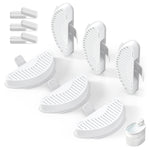- Introduction
- Importance of food and water for cats
- Common concerns about cats going without food and water
- The Significance of Water for Cats
- The role of water in a cat's body
- The consequences of dehydration in cats
- Factors affecting a cat's water intake
- How Long Can Cats Survive Without Water?
- Normal water consumption for cats
- Signs of dehydration in cats
- Duration a cat can go without water
- Addressing Dehydration in Cats
- Encouraging water consumption in cats
- Using cat water fountains to promote hydration
- Other methods to prevent dehydration in cats
- The Role of Food in a Cat's Hydration
- Water content in cat food
- Wet vs. dry cat food and hydration
- Importance of a balanced diet for cats
- How Long Can Cats Survive Without Food?
- Normal eating habits of cats
- Signs of malnutrition in cats
- Duration a cat can go without food
- Coping with a Cat's Refusal to Eat or Drink
- Reasons for a cat's loss of appetite
- Encouraging a cat to eat or drink
- When to seek veterinary assistance
- Encouraging a Cat to Eat/Drink
- Conclusion
- FAQs
1. Introduction
Cats are known for their independent nature, but they still rely on their human caregivers to ensure their basic needs are met. Among these needs, food and water hold utmost importance. Proper hydration is essential for a cat's overall health, as water plays a crucial role in various bodily functions. Similarly, a well-balanced diet ensures that cats receive the necessary nutrients for their growth and well-being.
Read more: How Long Can Cats Go Without Water?
2. The Significance of Water for Cats
Water is vital for cats as it aids in digestion, regulates body temperature, lubricates joints, and facilitates waste elimination. Dehydration can lead to serious health issues, including urinary tract problems and organ failure. Cats generally have a low thirst drive, which can make it challenging for them to consume sufficient water from a regular bowl.
3. How Long Can Cats Survive Without Water?
The duration a cat can go without water depends on several factors, including the cat's age, health condition, and environmental factors. On average, cats should consume around 3.5 to 4.5 ounces (100-130 ml) of water per 5 pounds (2.3 kg) of body weight daily. Signs of dehydration in cats include dry gums, loss of skin elasticity, and lethargy. If a cat is deprived of water for more than a few days, it can lead to severe health complications and even death.
4. Addressing Dehydration in Cats
Encouraging water consumption in cats is crucial to prevent dehydration. One effective method is the use of cat water fountains. These fountains provide a continuous flow of fresh water, mimicking a natural water source and attracting cats to drink more. Additionally, placing multiple water bowls around the house and ensuring they are clean and accessible can also encourage cats to drink more water.
5. The Role of Food in a Cat's Hydration
Cat food also plays a significant role in maintaining hydration. Wet cat food typically contains a higher water content compared to dry kibble, contributing to a cat's overall water intake. However, it is essential to provide a balanced diet that meets the cat's nutritional requirements. Combining wet and dry food can be a suitable approach to ensure hydration while maintaining a balanced diet.
6. How Long Can Cats Survive Without Food?
Unlike water, cats can survive for a longer period without food. However, prolonged fasting can lead to various health issues.
Cats are obligate carnivores, which means they require a diet predominantly composed of animal protein to thrive. In the wild, cats hunt and consume small prey multiple times a day. This natural instinct influences their eating habits, as they are biologically programmed to eat small, frequent meals.
Signs of Malnutrition in Cats
Malnutrition can have severe consequences for cats. Some signs indicating that a cat may be experiencing malnutrition include weight loss, lethargy, dull coat, weakened immune system, and digestive issues. Cats require a balanced intake of essential nutrients, including proteins, fats, carbohydrates, vitamins, and minerals, to maintain optimal health.
Duration a Cat Can Go Without Food
A complete lack of food intake can result in muscle wasting, weakened immune system, and organ failure. It is crucial to monitor a cat's eating habits and seek veterinary assistance if a cat refuses to eat for more than 24-48 hours.
7. Coping with a Cat's Refusal to Eat or Drink
If a cat shows a loss of appetite or reluctance to drink, it is important to identify the underlying causes. Stress, dental problems, or certain medical conditions can contribute to a cat's refusal to eat or drink. Providing a calm and comfortable environment, offering a variety of food options. If your cat goes without eating for more than 24-48 hours, it is crucial to consult with a veterinarian to determine the cause and appropriate course of action.
8. Encouraging a Cat to Eat/Drink
Encouraging a cat to eat involves understanding their preferences and providing a suitable environment. Some strategies to stimulate a cat's appetite include:
- Offering a variety of high-quality, palatable foods.
- Ensuring a calm and stress-free feeding environment.
- Feeding small, frequent meals throughout the day.
- Warming up the food slightly to enhance aroma and appeal.
- Trying different feeding methods, such as interactive feeders or food puzzles.
Conclusion
Proper hydration and a well-balanced diet are vital for the health and longevity of cats. While cats can survive for a limited time without food, they require a consistent supply of water to maintain essential bodily functions. As responsible cat owners, it is crucial to monitor their water intake, provide access to fresh water sources such as cat water fountains, and ensure they receive a nutritionally balanced diet. In case of any concerns about a cat's eating or drinking habits, consulting with a veterinarian is always recommended.
FAQs
-
Can cats drink milk instead of water? Cats are lactose intolerant, and milk can lead to digestive issues. Water is the best choice to keep cats hydrated.
-
What are the benefits of using a cat water fountain? Cat water fountains provide a continuous flow of fresh water, attracting cats to drink more and promoting hydration.
-
How can I encourage my cat to drink more water? Placing multiple water bowls around the house, using a cat water fountain, or adding water to wet food can help encourage water consumption.
-
Is wet or dry food better for my cat's hydration? Wet cat food has a higher water content, contributing to a cat's hydration. However, a balanced diet that meets nutritional needs is essential.
-
What should I do if my cat refuses to eat or drink? Monitor the situation closely and consult with a veterinarian if a cat refuses to eat or drink for more than 24-48 hours.
-
Can cats survive by drinking from sources other than water bowls? Cats may drink from alternative sources such as faucets or dripping taps, but providing a dedicated water source is important for their well-being.
-
How can I make sure my cat's water is clean and appealing? Regularly clean water bowls or cat water fountains and change the water frequently to ensure it stays fresh and appealing to cats. A smart cat water fountain can filter the water to ensure clean water anytime. Shop automatic cat water fountain>
-
Can dehydration in cats be fatal? Yes, dehydration can lead to severe health complications and even death in cats if left untreated.
-
Are there any medical conditions that can affect a cat's water intake? Yes, certain medical conditions such as kidney disease or urinary tract infections can impact a cat's water intake and hydration levels.
-
When should I seek veterinary assistance for my cat's hydration issues?
If you notice signs of dehydration or if your cat's refusal to eat or drink persists for an extended period, it is best to consult with a veterinarian for guidance and proper diagnosis.












